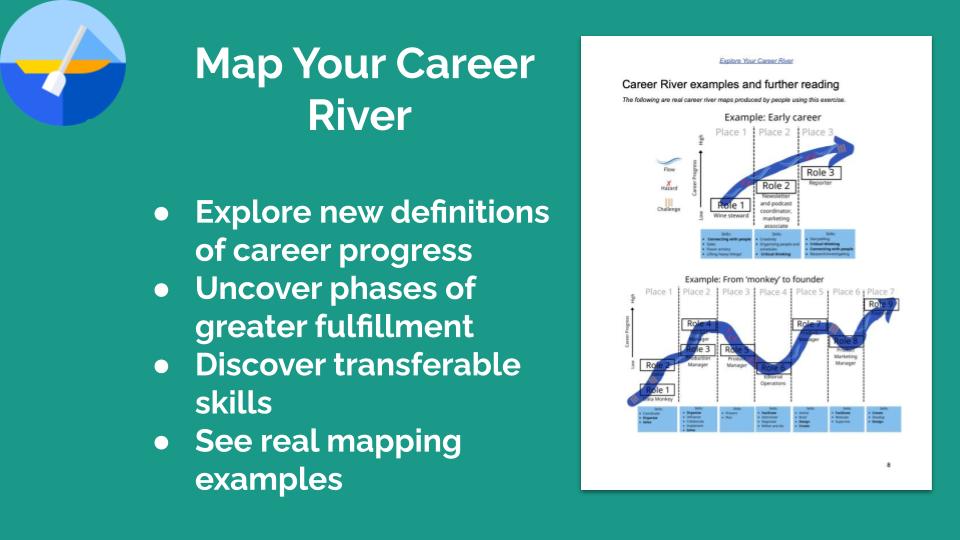Fixing the promotion problem
🚨Reminder! Starting next week, only paying subscribers will receive weekly Career River dispatches. Upgrade today for an instant downloadable Map Your Career River worksheet, and join me next week for a Q&A with our Navigator of the Month on finding opportunities after being laid off:
Have you ever looked at the next rung up the career ladder and thought, “Do I actually want to do that job?”
It’s odd that once you’re really good at doing something, you get bumped into a new role that usually means doing something else. That’s why I was so interested to learn about a newsroom that has found a way to promote reporters while allowing them to keep doing what they love.
The Appeal is one of the first worker-led nonprofit newsrooms in the U.S., after staff unionized in 2021 to shift from a “low democracy” to a “high democracy” workplace. The leadership team of Tara Francis Chan and Molly Greene found it wasn’t easy to shake the old hierarchy. When small groups were asked what they wanted the organizational structure to look like, they came back with pyramids.
“None of us wanted that structure, but it was so ingrained in us,” said Francis Chan, managing editor and operations director.
Francis Chan and Greene wanted to figure out how staff could have more responsibility and grow in their careers, without needing to become managers and move away from work they enjoyed. The result, they said, looks more like a web than a triangle.
Manage projects, not people
The Appeal is not alone in exploring solutions to the promotion problem. Microsoft, for example, has created “dual career ladders” — one track for programmers on the technical side, and one for great managers.
The Appeal’s leaders looked at different models of career progression and ultimately created three tiers for their seven-person team:
- worker,
- coordinator
- and leader.
Reporter and editor are jobs, and depending on the level of responsibility individuals want, they could be on different tiers. Coordinators manage projects, not people, and receive additional compensation for the additional responsibility they hold. People can also receive increased compensation within each tier.
The editorial coordinator, for instance, has responsibilities including managing meetings, timelines and story ideas. Once a story is approved, after the entire team assesses pitches, it moves through a traditional process, where the reporter is assigned an editor and the story goes through rounds of review before publication.
“The structure really does allow for a combination of acknowledging that some people do want to hold more work and should be compensated for that, but also there are people who don't. We have reporters who just want to be reporters,” said Greene, The Appeal’s strategy and legal director.
“People really appreciate the sense of autonomy, independence and control they have over their work.”
🎉 Don’t miss out on special resources for Career River subscribers!

“It’s a genius practice for helping understand and navigate next steps in your career.” - Nina Joss
“Career River is a new way to think and consider your relationship to work, life and what you want from both. Take a look and consider supporting Bridget's keen insights. They've helped me paddle through a career transition.” - Dustin Block
“Becoming a subscriber to the Career River has been a game-changer for me. It’s more than just career advice — it’s a guide to aligning my personal and professional life with clarity and positivity.” - Laura Lund
Thinking differently about care
Greene said The Appeal committed early on to evolving as an organization, and they are continuing to refine their structure. One aspect they’re working on is increasing the clarity around who staffers are accountable to and who’s responsible for which decisions.
While not everyone will be able to build a care-centered workplace from the ground up, there are any number of ways you can apply elements of The Appeal’s approach to your own workplace. Francis Chan and Greene have put together a toolkit to help journalists transform their newsrooms in big and small ways.
“You don’t have to restructure your entire newsroom to think differently about how you can care for your team and the people around you,” Greene said. “We've really tried to present what we've done in a way that allows people to borrow what works for them, whether it's connecting with a colleague, or having a hard conversation, or bringing ideas to your boss, or stepping into a leadership role in a new way.
”I would say think big, no matter how small a change you can make.”
At the end of our conversation, I asked Greene and Francis Chan why they would go to the trouble of restructuring work in this way. Greene brilliantly pointed out that it’s still a lot of work to hate your workplace.
“I would rather spend the time working on things that are going to make things better, rather than spend time ruminating on the things that aren't working without any power to change them,” she said.
Traditional organizations spend lots of time, money and effort on thinking about their organizational structures, Francis Chan said. The difference is The Appeal is rethinking what that could mean, particularly in an industry plagued by burnout.
“We wanted to create a space where journalists were cared for and journalists had a say and transparency in the newsrooms that shape their lives,” Francis Chan said. “That has been a lot of hard work, but it's really worthwhile.
“It has to start somewhere, and it may as well start here.”
Happy navigating,
Bridget
Next week: How to find new opportunities after being laid off. Don’t miss our Navigator Q&A for paying subscribers!
*If you’re not currently getting paid for your work, you don’t need to pay for Career River. Email me at exploreyourriver@gmail.com for access.
🔗 Links:
Guidance on how to apply The Appeal’s approach: We’ve created a democratic, worker-led, care-centered newsroom (RJI)
Research: Do People Really Get Promoted to Their Level of Incompetence? (Harvard Business Review)

Member discussion